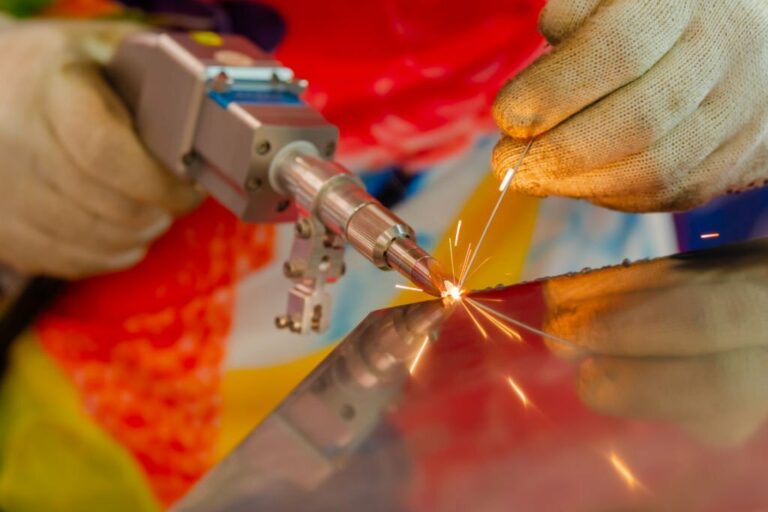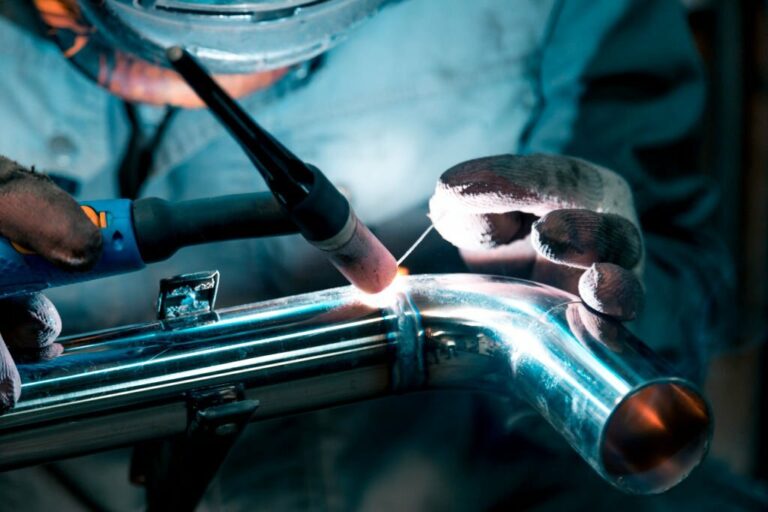We are all familiar with metal welding. We can often see them in our nearby repair or metal workshops. Some of us may not be familiar with different types of welding and their differences. Generally, welding plays a pivotal role in various industries. It is the backbone of the construction, manufacturing, and fabrication processes. Laser welding and TIG welding are both popular welding methods in these industries. However, some of you may need help choosing the appropriate method for your project. Thus, understating Laser Welding vs TIG Welding is necessary.
This article will briefly discuss the fundamental differences between laser and tig welding. Consequently, we’ll judge which solution is best for your project. Let’s explore more.
What is Laser Welding?
Laser welding is an advanced and exact welding technique. Laser machining is one of the best technologies humans have ever discovered. The laser welding process utilizes the energy of a laser beam to join materials.
The working principle of this technique is relatively like other laser machining methods. A laser welder creates a high-intensity laser on the workpiece and hits the surface of the metal. This laser beam leads to the localized melting and fusion of the materials. So, the laser beam serves as a concentrated heat source. It allows for precise control over the welding process.
Laser welding is prevalent in many industries since it offers the tightest tolerances. We can see the use of this technology in the aerospace, electronics, medical, automotive, and jewelry industries. Laser welding is ideal for welding light and thin metals. In the electronics industry, the laser is utilized for welding small & delicate components. In addition, the laser is employed for intricate welding in jewelry production in the jewelry industry. The high-quality welds of laser beam welding create minimal heat-affected zones. As a result, laser welding is a preferred choice in these industries. Compared to TIG welding, laser beam welding is faster and more precise.

What is TIG Welding?
TIG welding stands for Tungsten Inert Gas Welding. It is an arc welding process that uses a non-consumable tungsten electrode to create a weld. As the name implies, this method uses inert gas, typically argon or helium. You may wonder about the necessity of inert gases in the welding method. It technically shields the weld area from atmospheric contamination. TIG welding is mainly famous for its ability to produce high-quality welds.
The working principle of TIG welding is simple. The process establishes a stable arc between the tungsten electrode and the workpiece. The intense heat generated melts the base metal to reinforce the weld joint. At this stage, the tungsten remains intact, and the inert gas shield ensures a clean and controlled environment for welding.
The application of TIG welding can be observed in many industry fields. The method’s versatility makes it well-suited for various applications across these fields. We can find the most common applications in the aerospace, automotive, and electronics industries. Compared to laser welding, TIG welding offers the most cost-effective solution. They are also flexible and efficient for many applications.

Difference Between Laser Welding And TIG Welding
Both laser welding and TIG welding are popular in many industries. You know, they come with different approaches to welding materials. Besides, both methods are durable & accurate. However, their methods are essentially different from one another. Here is the table for your review. It effectively emphasizes the distinct differences between the two approaches.
| Aspect | Laser Welding | TIG Welding |
| Process Description | The method uses a focused laser beam to melt & fuse metals. | TIG welding uses a non-consumable tungsten electrode and inert gas for arc welding. |
| Speed & Efficiency | High welding speed & suitable for mass production | TIG welding is a slower and more time-consuming technology than laser welding. |
| Precision & Accuracy | Laser welding offers more precise results than TIG welding. | It is relatively less accurate than laser welding. |
| Heat-affected zone | Minimal heat-affected zone; reduces material distortion | Generates a larger heat-affected zone, the potential for more distortion in thicker materials. |
| Versatility in materials | Appropriate for a wide variety of metals | Also versatile for various types of metals |
| Equipment costs | Higher Initial costs; Relatively expensive than TIG Welding | Generally lower initial equipment costs; more suitable for small business |
| Applications | Widely used in the aerospace, electronics, and jewelry industry. | Commonly used in automotive, construction, manufacturing, and others. |
Laser Welding vs TIG Welding: Speed & Efficiency
One of the primary differences between laser welding and TIG welding is their speed & Efficiency. Laser welding offers high welding speed. In this case, the speed factors include the laser owner, material properties, and joint configuration. Since laser welding is fast, it is ideal for mass production in the automotive and electronics industries.
On the other hand, TIG welding is slower than laser welding. A welder normally performs TIG welding, so it takes more than an automated machine. In addition, the chances of errors are more significant than in laser welding. However, TIG welding also offers efficiency in precise welds. One of the significant advantages of using this method is their ability to work with thicker materials.
TIG vs Laser Welding: Precision & Accuracy
Both Laser welding and TIG welding offer greater precision & accuracy. Laser welding is more precise than other methods because of the focused laser beam. The concentrated laser with minimal heat-affected zone ensures minimal distortion. This level of accuracy made laser welding ideal in electronics and medical device fabrication.
On the other hand, TIG welding offers less precision than laser welding. You know this method involves manual manipulation and filler rod usage. As a result, skilled welders can only achieve a certain level of precision. Therefore, for TIG welding, skill mastery is essential for quality welds.
Laser Weld vs TIG: Head-affected Zone
The heat-affected zone (HAZ) is the region surrounding the welding during welding. This zone is where the primary material undergoes heat changes without completely melting. HAZ is a critical aspect of welding. You know it influences the material’s properties.
Laser welding typically minimizes this heat-affected zone by concentrating laser beam energy precisely. As a result, it also reduces thermal diffusion. Consequently, you can get less material distortion and preserve the base material’s properties. On the other hand, TIG welding generates a larger heat-affected zone compared to laser welding. It happens due to the broader heat dispersion associated with the welding arc. Consequently, this increased heat exposure may lead to significant changes in material properties.
Laser Welding vs TIG Welding: Versatility
Both laser welding and TIG welding are versatile on various types of metals. But when we talk about the suitability, we can find the differences. Laser welding is popular for welding stainless steel, aluminum, titanium, copper, and brass. On the other hand, TIG welding prefers carbon steel, stainless steel, aluminum and its alloys, copper & brass, and nickel alloys.
Technically, TIG welding is more suitable for reflective surfaces. Some laser welders from Hanten CNC are ideal for welding these metals. Therefore, while choosing a laser welding machine, you must consider some technical terms.
Laser Welder vs TIG: Cost Considerations
Laser welding equipment requires higher initial investment due to the advanced technology involved. High-power laser systems & precision optics contribute to the overall cost. On the other hand, the specialized knowledge for operating the machine can also add to the initial cost. Although it has higher upfront costs, it often offers advantages in terms of speed and efficiency.
On the other hand, TIG welding generally has lower initial equipment costs. As a result, this welding method can be a cost-effective solution for smaller businesses. It is also suitable for applications for those with diverse welding needs. However, maintenance, energy consumption, and consumable usage may increase the after-purchase costs.
Laser Welding vs TIG Welding: Which One is Better?
Choosing between laser welding and TIG depends on specific applications and their requirements. Laser welding is ideal for high-precision applications. You know, it is necessary for applications demanding acceptable welds, little heat-affected zones, and high speed. Typical applications can be found in the aerospace, electronics, and jewelry industries. On the other hand, TIG welding is suitable for applications involving thick materials. Popular applications can be observed in construction, automotive, and artistic projects.
Typically, the factors influencing your choice depend on several key points. First, what is the permissible range of precision in your application? Does your requirement involve mass production? Next, heat-affected zones may also be an issue in your application. Consider choosing laser welding in these cases. For versatility, both laser welding and TIG welding are suitable. Finally, choose the automated welding method if you are looking for mass production. Laser welding systems often integrate well with automation.
Above all, the laser welding process is the most appropriate due to its greater precision, speed, and small heat-affected zone. These laser welding machines are reliable and efficient. It ensures high-quality and precise welding processes.
Conclusion
Let’s wrap everything up! Laser welding and TIG welding are both famous welding technology used in various applications. Laser welding excels in speed, precision, and minimal heat-affected zone. On the other hand, TIG welding offers versatility to diverse materials and sizes. While choosing between these two methods, consider the project’s specific needs. Emphasize precision and efficiency for high-tech applications.
Laser welding is the most commonly used method in modern manufacturing. Precision and tight-tolerance products are now essential. As a result, old manual procedures need to be revised in these industries. Every industry specializes in developing this technology to provide more dependable & efficient products.
